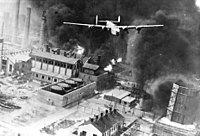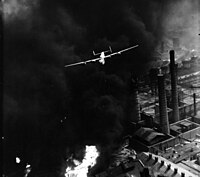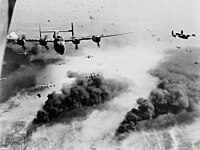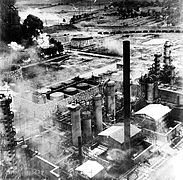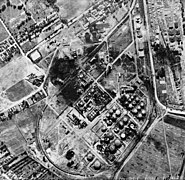Bombing of Bucharest in World War II
| Bucharest World War II bombings | |||||
|---|---|---|---|---|---|
| Part of Strategic bombing campaign in Europe | |||||
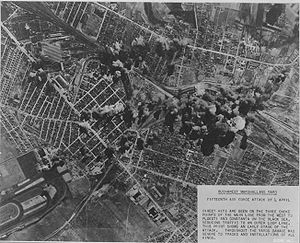 Bombing of the Gara de Nord marshalling yard (April, 1944) | |||||
| |||||
| Belligerents | |||||
|
|
| ||||
| Commanders and leaders | |||||
|
| |||||
| Casualties and losses | |||||
| Civilians: 5,524 killed, 3,373 wounded | |||||
The Bucharest World War II bombings were primarily Allied bombings of railroad targets and those of the Oil Campaign of World War II, but included a bombing by Nazi Germany after King Michael's Coup. Bucharest stored and distributed much of Ploiești's refined oil products.[1]: 190 [2]
The first operation was a sequence of 17 aerial bombardments, starting with the one of April 4, 1944. The bombings were carried out over a period of about 4 months by the United States Air Force and the British Royal Air Force, with approximately 3,640 bombers of different types, accompanied by about 1,830 fighters. As collateral damage, 5,524 inhabitants were killed, 3,373 were injured, and 47,974 were left homeless.[3] The second operation was executed by the German Luftwaffe in retaliation for Romania having changed sides (immediately after the fall of the fascist regime headed by Ion Antonescu), and took place on August 23–26, 1944.[4] Taking into account the large number of victims and damage caused, the aerial bombings of 1944 represent the greatest tragedy in the history of Bucharest in the twentieth century.[5]
Raids
| Date | Target/Topic | |
|---|---|---|
| 1944-04-04[6] | Railroad targets | |
| 1944-04-15[9] | Railroad targets | |
| 1944-06-10 | Romana Americana oil works, Ploiești | |
| 1944-06-28 | Oil refineries | |
| 1944-08-17/18 | Oil refineries | |
| 1944-07-31 | Oil refineries | |
| 1944-08-06 | Railroad targets | |
| 1944-08-23/24 & 24/25 |
-
One of the Operation Tidal Wave B-24s over a burning oil refinery at Ploiești, Romania, 1 August 1943.
-
The Sandman B-24, piloted by Robert Sternfels, as it emerges from a pall of smoke during the Tidal Wave mission.
-
"15th Air Force B-24s leave Ploiești, Romania, after one of the long series of attacks against the No. 1 oil target in Europe" (National Museum caption).
-
Oil storage tanks at the Columbia Aquila refinery burning after the raid of B-24 Liberator bombers of the United States Army Air Force. Some of the structures have been camouflaged.
-
Bomb damage visible in Columbia Aquila refinery in Ploiești, Romania.
-
B-24 Liberators at low altitude while approaching the oil refineries at Ploiești, Romania, August 1, 1943.
References
- ^ a b Stout, Jay, A.C. (2011). Fortress Ploesti: The Campaign to destroy Hitler's oil. Havertown, PA.: Casemate. ISBN 978-1-935149-39-2.
{{cite book}}: CS1 maint: multiple names: authors list (link) - ^ Dobrovicescu, Lucian. "Aprilie 1944. Moartea vine din cer: Bombardamentele aliate asupra României" [April 1944. Death comes from the sky: Allied bombing of Romania] (in Romanian). Historia. Retrieved October 18, 2020.
- ^ "Bombardarea Bucureștilor în '44: mii de morți și sute de clădiri făcute praf" [The bombing of Bucharest in '44: thousands killed and hundreds of buildings destroyed]. Adevărul (in Romanian). February 22, 2011. Retrieved October 18, 2020.
- ^ Armă, Alexandru (2019). "24 august 1944: Avioanele germane bombardează Bucureștiul" [August 24, 1944: German planes bomb Bucharest] (in Romanian). Historia. Retrieved October 18, 2020.
- ^ Armă, Alexandru. Rănile unui oraș: București bombardat (4 aprilie–26 august 1944) [Wounds of a city: Bucharest bombed (April 4–August 26, 1944)] (in Romanian). București: Editura Vremea. ISBN 9736457850. OCLC 988771379.
- ^
McKillop, Jack. "Combat Chronology of the USAAF". Archived from the original on 2007-06-10. Retrieved 2007-05-25.
1944: January Archived 2009-02-11 at the Wayback Machine, February Archived 2014-12-27 at the Wayback Machine, March Archived 2009-02-11 at the Wayback Machine, April Archived 2009-02-16 at the Wayback Machine, May Archived 2012-06-06 at the Wayback Machine, June Archived 2009-02-16 at the Wayback Machine, July Archived 2013-05-27 at the Wayback Machine, August Archived 2009-02-11 at the Wayback Machine - ^ a b Pruteanu, Cătălin (August 31, 2006). "Ia-ți Bucureștii – Cotroceniul liniștit" [Keep Bucharest – Cotroceni Is Quiet]. Jurnalul Național (in Romanian). Retrieved August 24, 2020.
- ^ USAF Historical Research Agency[specify]
- ^ "Campaign Diary". Royal Air Force Bomber Command 60th Anniversary. UK Crown. Archived from the original on 2005-06-01. Retrieved 2009-05-10.
1944: January Archived 2007-07-06 at the UK Government Web Archive, February Archived 2007-07-06 at the UK Government Web Archive March Archived 2007-07-06 at the UK Government Web Archive, April Archived 2006-02-21 at the Wayback Machine, May Archived 2013-04-09 at the Wayback Machine, June Archived 2007-06-11 at the Wayback Machine, July Archived 2007-07-06 at the UK Government Web Archive, August Archived 2007-07-06 at the UK Government Web Archive - ^ "461st Bombardment Group". Mission Records: April 1944.
- ^ a b Giurescu, Constantin C. (1966). Istoria Bucureștilor. Din cele mai vechi timpuri pînă în zilele noastre [History of Bucharest. From the earliest times to our day] (in Romanian). p. 190,212.
- ^ Mission histories for Bombardment Groups:
- "464 BG": "Our Missions: The 464 BG Mission List".[permanent dead link]
- "485 BG": "tbd". Archived from the original on 2011-07-24.
- ^ Macisaac, James, J. "The WWII History of James Macisaac and RAF 37 Squadron". Op 6 · Ploesti, Xenia Oil Refinery. Retrieved 15 July 2011.
{{cite web}}: CS1 maint: multiple names: authors list (link)
- History of Bucharest
- Oil campaign of World War II
- World War II strategic bombing
- Romania–United Kingdom military relations
- Romania–United States military relations
- Disasters in Bucharest
- 1940s in Romania
- 20th century in Bucharest
- Aerial operations and battles of World War II involving the United Kingdom
- Romania in World War II

